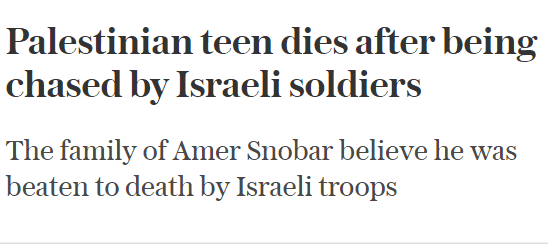When there are two wildly different versions of a story, and in the absence of conclusive evidence of either version being proven objectively correct, a responsible journalist should always strive to ensure that readers are presented with each narrative, along with additional relevant information, in a fair and equal fashion.
But the reporting of the recent death of a Palestinian youth in unclear circumstances in the West Bank this week by leading British newspaper The Daily Telegraph leaves much to be desired.
Join the fight for Israel’s fair coverage in the news
Two Contradicting Versions
As the Times of Israel reported, there were two versions of the story: According to the IDF, 18-year old Amer Snobar fatally injured himself while running away after throwing rocks at Israeli vehicles. But according to the Palestinians, troops allegedly shot and beat him to death while he was driving.
It’s clear that only one of these versions of the story can be true. And in the absence of certainty, journalists owe it to the readers to make clear that the circumstances behind the man’s death were unclear. They should also include information that would seem to strengthen or contradict either of the side’s stories
For example, the Times of Israel report mentioned that no damage from gunfire could be clearly seen on the car – highly relevant when considering the claim that Israeli troops were supposed to have shot the man while he was in the car.
How The Daily Telegraph Reported The Event
Instead of giving equal weight to each version, The Daily Telegraph allowed its headline and subheadline to reflect the Palestinian narrative alone. The headline, “Palestinian teen dies after being chased by Israeli soldiers,” leads readers to believe that Israeli soldiers were the cause of the teen’s death, and the subheadline, “The family of Amer Snobar believe he was beaten to death by Israeli troops,” reinforces the point, making the connection explicit.
 The first four paragraphs of the report by Campbell MacDiarmid, the Telegraph’s Middle East correspondent, are dedicated to further outlining the story as seen from the Palestinian side, with his family’s claims repeated and a Palestinian health ministry statement cited. Only in the fifth paragraph is the Israeli version of events introduced.
The first four paragraphs of the report by Campbell MacDiarmid, the Telegraph’s Middle East correspondent, are dedicated to further outlining the story as seen from the Palestinian side, with his family’s claims repeated and a Palestinian health ministry statement cited. Only in the fifth paragraph is the Israeli version of events introduced.
In all, four paragraphs were given to telling the Israeli narrative of the incident. By way of contrast, the Palestinian version was allocated far more column inches, with seven paragraphs. This fundamental imbalance, along with the headline and subheadline, thus creates the impression that the Palestinian version of the story is the more likely to be correct.
But there’s reason to believe that the Palestinian version is less likely to be true.
As David Lange of Israellycool has noted, the Palestinians had trouble sticking to one story, and multiple versions quickly arose of how Israeli soldiers allegedly killed Snobar.
In one version, the car was fired at. In another, the car broke down. In one version, the soldiers beat Snobar with their rifle butts. But in another, they attacked him with sticks. And in one version, it is claimed that the soldiers struck Snobar on the neck, while another version alleges that they merely held him by his neck while beating him. And there are more differences – an eyewitness contradicts himself when saying on video that he ran away, but that he was actually only two meters away from the scene.
So which is it?
Amer Snowbar’s friend recounts how Israeli soldiers horrifically beat Amer to death. pic.twitter.com/xK8KeXxvi4
— Salem Barahmeh (@Barahmeh) October 26, 2020
With reasons to believe that the Palestinians are spreading lies, possibly to deflect from the fact that Snobar may have been putting other lives at danger by hurling rocks at Israeli vehicles travelling at high-speed, a responsible journalist would at least investigate the circumstances further.
We don’t expect the media to take Israel’s side. We don’t expect the media to automatically believe the Israeli version of events. But we do expect the media to check all the stories they are being told, examine them, and expose gaping holes when they exist, as they do in the various Palestinian versions of events. That’s what the media is really there for, after all. And in unquestioningly spreading a clearly problematic narrative, the Daily Telegraph may well be complicit in repeating the latest blood libel against Israel.


